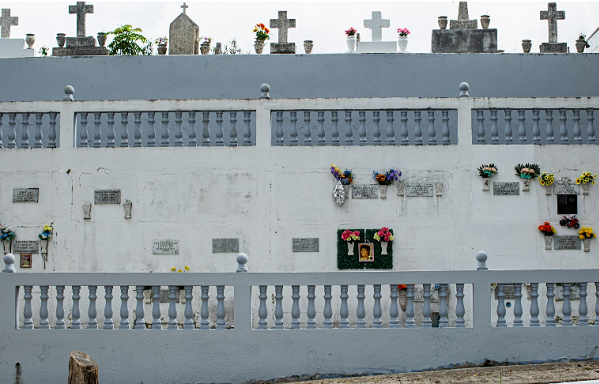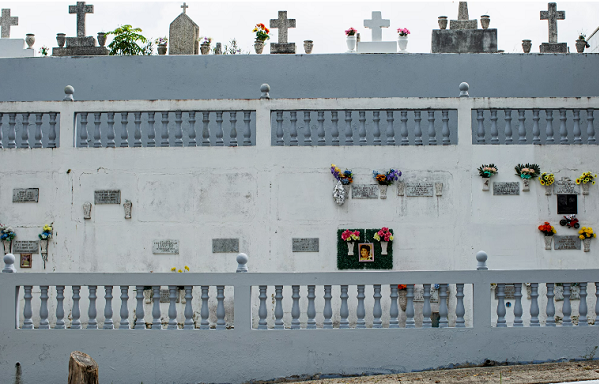
“Islanders died of chronic conditions and covid-19 in 2022 at numbers that surpassed even Hurricane Maria’s toll.” For complete article on Puerto Rico’s deteriorating health-care system by Jeniffer Wiscovitch, Andrew Ba Tran, Arelis R. Hernández, and Dylan Moriarty; with video by Zoeann Murphy, and photography by Erika P. Rodríguez, visit the Washington Post.
In a purple house along a narrow road in Puerto Rico’s Central Mountain Range, Margarita Gómez Falcón’s breathing suddenly grew labored one March evening. She called an ambulance and began a grim two-hour wait for paramedics to arrive.
Health services across this self-governing island have been deteriorating for years, contributing to a surge in deaths that reached historic proportions in 2022, an investigation by The Washington Post and Puerto Rico’s Center for Investigative Journalism has found.
The case of Gómez Falcón, 67, underscores the many ways a faltering medical system has contributed to elevated death rates. She had struggled with kidney disease, covid-19, and breathing problems requiring the use of oxygen. But access to dialysis and other specialized medical care had dwindled, especially since Hurricane Maria devastated the island in 2017. Aguas Buenas, a small, working-class town in the central highlands, had one working ambulance for its 25,000 people when Gómez Falcón called for help, so dispatchers sent a private one that had trouble finding her home in the town’s winding back roads. As her breathing slowed, her family members said, they gathered around her and prayed for paramedics to arrive in time. When they finally pulled up, she was already dead. [. . .]
Puerto Rico, with a population of 3.3 million people, experienced more than 35,400 deaths last year. That’s nearly 3,300 more than researchers would ordinarily expect based on historic patterns, according to a statistical analysis by The Post and Puerto Rico’s Center for Investigative Journalism (CPI).
This “excess mortality” — a term scientists use to describe unusually high death counts from natural disasters, disease outbreaks or other factors — resulted in part from a covid spike early last year that killed more than 2,300 people, health data shows.
But elevated death rates continued in the months after covid subsided, indicating a broader breakdown as the island lost medical staff and services and younger Puerto Ricans moved away, leaving behind a population that is increasingly elderly and facing age-related health complications.
The recent jump in mortality is the latest warning sign that years of natural disasters and financial crises have taken a deadly toll. Last year’s spike was concentrated among Puerto Ricans over age 65, with other age groups dying at more typical rates, the analysis found. If Puerto Rico had a more typical population of younger people, the death rate in 2022 would have been the same or potentially even lower than in the rest of the United States, the statistical analysis showed.
“These types of events, both hurricanes and earthquakes, as well as pandemics, have made evident the vulnerability of many older adults who live alone, many of whom live below the poverty line, who do not have the most basic resources to face that type of adversity,” said José Carrión-Baralt, a professor in the gerontology program at the Recinto de Ciencias Médicas Graduate School of Public Health in San Juan, Puerto Rico’s capital and biggest city.
Last year, 110 Puerto Ricans died per 10,000 residents, a rate that is nearly 11 percent higher than in the United States overall. That marks a reversal from years past, when the island had lower or similar death rates compared with the United States as a whole. Even the wealthiest Puerto Ricans experienced death rates last year similar to those long suffered by poorer communities.
Puerto Rico’s death rate in 2022 surpassed that of any other year in the past two decades, including 2017, when Hurricane Maria devastated large swaths of the island, according to the analysis. The increase in deaths appears to have continued into 2023, with preliminary data for the first quarter showing that the death rate remained elevated. [. . .]
Puerto Rico’s Health Department has acknowledged that the island’s mortality rate rose to unusual heights in 2022, although its statistics are slightly different from the ones found in this analysis because researchers used different estimates for each municipality’s population. Officials have said they believe covid played a role in the surge of deaths, as did the shortage of doctors on the island, but health officials did not investigate the causes in their analysis.
“Right now, the conversation has focused on the cause of greatest impact, covid-19, which triggered the highest number of hospitalizations and deaths,” said Melissa Marzán Rodríguez, chief epidemiologist for Puerto Rico’s Health Department.
The analysis by The Post and the Center for Investigative Journalism, which is the first to comprehensively examine the reasons for the surge in mortality, confirms the role of covid and the shortage of doctors, but also points to other problems. Puerto Rico’s leading killers last year were covid, cardiovascular disease, Alzheimer’s disease, drug overdoses, kidney disease and dementia — most of which are potentially less lethal with routine medical care.
Health data shows that in 2022, compared with the historical average from 2015 to 2021, deaths from Alzheimer’s increased by 26 percent, heart disease by 11 percent and mental health causes by 53 percent, with most of those deaths from substance abuse or dementia. Alcoholism also was listed as a leading cause of death.
Reversing Puerto Rico’s surge in death rates, experts said, would require addressing social, economic and political problems that have undermined medical services for those who need them most.
The death rate in Aguas Buenas increased by nearly 50 percent in 2022 compared with the town’s historical average — the largest increase of any community in Puerto Rico.
As Puerto Ricans strove to rebuild in the months after Maria struck, an estimated 120,000 people — most of them of working age — moved away, according to the U.S. census. Accelerated migration continued through the end of the decade, and birthrates also fell. Puerto Rico’s overall population fell by nearly 12 percent from 2010 to 2020.
Sicker and older adults were left behind, making Puerto Rico one of the most rapidly aging societies on the planet. More than 1 in 5 residents are now over 65, which is higher than the U.S. average, according to an analysis by Hunter College’s Center for Puerto Rican Studies. [. . .]
In Puerto Rico overall, government data shows there are more than 400 fewer doctors than in 2019. Less than a third of the island’s municipalities have hospitals with accessible beds, with some Puerto Ricans living up to 20 miles away from the nearest facility, according to data from Puerto Rico’s Heath Department. In 2022, municipalities with no hospitals saw greater death rates than their historical averages. [. . .] For full article, see https://www.washingtonpost.com/nation/interactive/2023/puerto-rico-deaths/
“Islanders died of chronic conditions and covid-19 in 2022 at numbers that surpassed even Hurricane Maria’s toll.” For complete article on Puerto Rico’s deteriorating health-care system by Jeniffer Wiscovitch, Andrew Ba Tran, Arelis R. Hernández, and Dylan Moriarty; with video by Zoeann Murphy, and photography by Erika P. Rodríguez, visit the Washington Post. In a purple house along a narrow road








